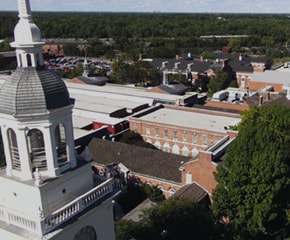
Henry Ford's Rouge
Henry Ford’s ultimate goal was to achieve total self-sufficiency by owning, operating and coordinating all the resources needed to produce complete automobiles. His Ford Motor Company once owned 700,000 acres of forest, iron mines and limestone quarries in northern Michigan, Minnesota and Wisconsin. Ford mines covered thousands of acres of coal-rich land in Kentucky, West Virginia and Pennsylvania. Ford even purchased and operated a rubber plantation in Brazil. To bring all these materials to the Rouge, Ford operated a fleet of ore freighters and an entire regional railroad company. Ford’s ambition was never completely realized, but no one has ever come so close on such a grand scale. At no time, for example, did Ford have fewer than 6,000 suppliers serving the Rouge.
The Rouge Fires Up
Ford began buying the property that was to become the Rouge in 1915. In total, he acquired a 2,000-acre stretch of bottomland along the Rouge River. The Rouge River property still was not earmarked for any particular use. Ford had even considered turning the land into a large bird sanctuary. That changed near the end of World War I, when Undersecretary of the Navy Franklin D. Roosevelt engaged Henry Ford to build boats.

In 1918, a three-story structure, Building B, was erected on the Rouge site to build Eagle Boats, warships intended to hunt down German submarines. Building B was the first substantial Rouge building and became a part of the Dearborn Assembly Plant until it was demolished in 2008. Although the war ended before the Ford Eagle Boats ever went into action, the effort did allow Ford to widen the Rouge River substantially, presenting the possibility of bringing ore boats up the river.
The Rouge soon became the destination of massive Ford lake freighters filled with iron ore, coal, and limestone. The first coke oven battery went into operation in October of 1919, while blast furnaces were added in 1920 and 1922. Iron from the furnaces was transported directly to the foundry where it was poured into molds to make engine blocks, cylinder heads, intake and exhaust manifolds, and other automotive parts. The foundry covered 30 acres and was, at its inception, the largest on Earth. In 1926 steelmaking furnaces and rolling mills were added. Eventually, the Rouge produced virtually every Model T component, but assembly of the Model T remained at Highland Park.
The First Vehicle Assembly
The first land vehicles actually assembled in the Rouge were not cars but farm tractors. No sooner had Henry Ford achieved low-cost transportation with the Model T than he set his sights on doing the same for the world’s farmers. In 1921 production of the world's first mass-produced tractor, the Fordson, was transferred from the original Dearborn plant to the Rouge.
Ford put a mammoth power plant into operation in 1920 that furnished all the Rouge's electricity and one-third of the Highland Park Plant's needs as well. At times, surplus Rouge power was even sold to Detroit Edison Company. An innovative glass plant began operation in 1923. Utilizing a continuous process that Ford had helped develop, it produced higher quality glass at lower cost. In 1928 the Model A became the first low-priced car to use laminated safety glass. By 1930 the Ford was making its own safety glass at the Rouge.
The Rouge achieved the distinction of automotive "ore to assembly" in 1927 with the long-awaited introduction of the Model A. Building B would be the home of assembly operations from that time forth.
Albert Kahn Design
Most of these buildings, and several hundred more in the Ford empire, were designed by Albert Kahn, one the most renowned architects of his day. Although the buildings were designed pragmatically for their manufacturing function, Kahn managed to add a sense of light and air. When the Rouge glass plant was erected with heavily glassed upper walls and ceiling, it was called "the single factory that carries industrial architecture forward more than any other."

Unionization & United Auto Workers
By 1928, the complex was complete, yet it was never settled. The Rouge continued to operate throughout the Great Depression, yet Ford’s obsession with ever-increasing cost reductions through methodical efficiency studies made life difficult for workers. On May 26, 1937, when a group of union organizers led by Walter Reuther attempted to distribute union literature at the Rouge, Ford security and a gang of hired thugs beat them severely. It would be known as the Battle of the Overpass and became a pivotal event for the United Auto Workers and other unions.
The Rouge settled with UAW representation before World War II broke out. During the war the giant complex produced jeeps, amphibious vehicles, parts for tanks and tank engines, and aircraft engines used in fighter planes and medium bombers.
The Rouge after Henry Ford
In 1947, at the pinnacle of the Rouge’s success, Henry Ford died. The roar of the Rouge began to fade as Ford Motor Company embarked on a new era that stressed decentralization and a more global approach.
Henry Ford II and his new team of "Whiz Kid" managers continued to fully employ the Rouge through the late 1960s, operating in a distinctly different world from Henry Ford. For one, there was a growing awareness of the environment. In the early days of American industrialization, smoke rising from a stack was a positive sign of full employment. As industry matured, government and manufacturers alike became aware that black smoke had other implications.

Air and water quality standards were developed by government agencies. More manufacturing facilities located within a community, accumulatively adding to emissions, meant more stringent controls. This, in part, led to closure of some older facilities. The Rouge, the largest single industrial complex in the world, probably would be the last of its kind.
Decentralization
The company grew to rely more and more on an ever-increasing cadre of suppliers and to methodically extract itself from other fields such as mining, lumbering and glass making. In 1981, steel-making operations at the Rouge became part of a new independent company. When these operations were sold to Rouge Steel in 1989, Ford gave up ownership of all Rouge River frontage and boat docks, as well as about 45 percent of the original 2,000 acres. Over time, the number of operations and jobs at the Rouge dropped. Economic pressures mounted to retire old brownfield manufacturing facilities and to replace them with state-of-the-art greenfield plants.
The Rouge, however, had evolved into a community with a strong sense of its own identity. Families worked from generation to generation in the Rouge, and few were willing to walk away from their hard-earned heritage. That fact became clear in 1992 when the only car still built at the Rouge, the Ford Mustang, was about to be eliminated and assembly operations in Dearborn Assembly terminated.
UAW Local 600, in cooperation with Alex Trotman, then president of Ford’s North American Operations, set out to keep the Mustang in production and to keep production in the Rouge. "Save the Mustang" became synonymous with "Save the Rouge." Working together, the company and the UAW established a modern operating agreement and fostered numerous innovations to increase efficiency and quality. The company, for its part, would redesign and reintroduce the Mustang, and invest in modern equipment.
The Rouge Enters the New Millennium
In 1997, the Rouge was making a comeback. UAW Local 600 membership and the company approved the Rouge Viability Agreement, and the Ford Board of Directors agreed to modernize the company’s oldest and largest manufacturing complex. The first efforts focused on extensive renovations to the Dearborn Engine and Fuel Tank Plant and other plants at the Rouge. Dearborn Assembly Plant would get an environmentally advanced paint operation, and plans called for CMS Energy to develop an entirely new power plant by 2000.
Ground was already being cleared for the new high-efficiency power plant when tragedy struck. The Number Six boiler at the Rouge Power Plant exploded and six employees were killed. A dozen more were seriously injured.
Within two hours of the explosion, Ford Chairman and CEO Bill Ford arrived at the scene, offering whatever support he could. "Our employees are like extended members of our family," Ford said, "My heart sank. It’s about the worst feeling you could ever have."
The Rouge entered the new millennium humbled by disaster and downsizing, yet still an industrial giant. About 6,000 Ford employees work at the Rouge. Now called the Ford Rouge Center, the 600-acre site remains Ford Motor Company’s largest single industrial complex. And a massive revitalization effort is under way to restore this icon’s glory.
Learn more:


